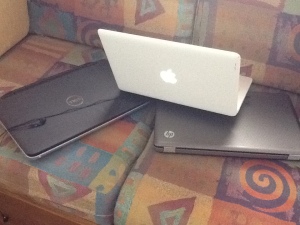My future vision is bright. The world is increasingly becoming more and more technology oriented and technology literate. I see this continuing at a rapid pace. I anticipate a time when technology devices will be accessible and affordable for everyone, everywhere. I think in 2020 it will start to happen in schools since there will be more 1:1 programs for kids to take home devices. I think that neighborhoods will have free Wi-Fi. This will eliminate the potential barrier to technology teachers fear when there is an assignment from home involving technology.
I think business and politics will help to push the 21st century entrepreneurial, communication, and collaboration skills that pair so perfectly with technology. I see even more competition for jobs as education and opportunities increase worldwide. This will increase the need for being multilingual. Because of increased contact with native speakers I see a world where it will be easy to learn a language if you are a child because of virtual teachers, formal and informal. I think communication will cause language learning to happen more naturally with those you are connected t o world-wide and apps to help the learning occur more efficiently. Can you imagine an avatar with the ability to hear the sounds you produce and know exactly which game to use to design remediation for you?
Students today are very comfortable with technology and using web tools to figure out how to do things and to find answers for what they want to know. I see learning as becoming more global rather than school or classroom centered. Knowledge is everywhere and teachers will assist students to get at the best content and to research critically and safely. Teacher education, like most college education, will be free and will take place in MOOCs. Those individuals who think in a more linear fashion will start to disappear or learn to compensate out of necessity as the world uses more nodes and admits that connectivisim is a learning theory after all. Professional development will continue in this fashion, as well.
Many of us became teachers because we wanted to impact the lives and futures of students, and we do. Teachers will continue to make impacts. I see in the future educators becoming even more important to students. They will have the role of setting students on the course of learning that meets an individual’s learning preferences and learning passions. I imagine in just six, short years there will be apps that will assist with this task. Students will have more choices about what things to learn and teachers will guide them to the right technology and help build learning networks and connections.
New technology will mean not just new applications but also new ways for students to engage in learning. I believe more content will be delivered in a digital fashion. At the present time, using Skype or Face Time is mostly seen as more of a recreational activity to contact personal friends and family. I predict that future students will use it to contact experts and even peers around the world. Students are already using so many interfaces, including education, as an anytime, anywhere platform, they will need contacts in different time zones to communicate and get their questions answered. Skype is being used more and more for presentations so I do not for see travel for routine business as much in the future. I see more virtual trips and experts coming to the learner via this platform.
Earlier, I wrote a blog about going paperless. Greener spaces and paperless places are certain to be in place in the future. Students will surely be creating and crafting and sending works rather than using paper and pen. The rapid pace that new information is being shared, and new theories and inventions are being created, means we are certain to be operating with virtual texts instead of books that would probably be out of date before the ink dries. I love how, even now, students can use visual and video encyclopedias and dictionaries to make learning engaging and sensory.
Collaborative work, like that of Wikipedia, will not seem strange in the future. Collaborative work with people you will never meet will be the norm. Once upon a time students were told not to share work and answers with peers. We are already moving toward using the web instead of memorizing facts and figures. We will all be urged to process and rethink the meaning of things deeply and share with as many people and in as many ways as we can. I think this will lead to more creativity in the future. I predict copyright will move back towards making works available for sharing instead of being sold to publishers for profit. Creativity and sharing will lead to more nonprofit organizations because it will not be more important to heap monetary rewards and personal acclaim than to share right away so your ideas and findings can be tested, prodded and poked as it is being pushed lightning fast in all directions. That is how current diseases will get cures and we will just get to run marathons for recreation not money to support causes.
I envision in the future more authentic activities and more opportunities for students to share work. I see teachers and students really mastering the art of mashups and app smashing. I think it is fabulous to concentrate on the skills and have with the swipe of a finger, or through voice activation, the perfect applications and tools to assist and engage learners.
I think there will be more student collaborations through Google Docs with all of the many useful tools and enhancing applications. I see more multimedia presentations as part of what students will use as the framework for learning that caters to all multiple intelligences. When students write papers, even today, embedded videos and photos and info graphics are used automatically. I think what we call “writing” will probably be more audio-visual. These works will probably be quickly translated in whatever the future devices will be. Of course photos and shared videos will continue. I do think we will be less egocentric and Selfies will not be the thing to do.
Gaming is going to be seen as a much more useful teaching tool. I think there will be less resistance to letting students “play.” The features of games that attract and engage students need to be capitalized on to increase learning and community building not shut it down and feel this will happen and be a non-issue in the future. I think adults who are learning to play and explore with tech tools will be ahead of the pack in a few years. The young will continue to lead the older population as they embrace technology and become even better teachers. Older individuals will have an easier time since tech apps are becoming less and less complicated and you can just say what you want.
Social networking is sure to increase. Older people are using Face Time and Skype to keep in touch with loved ones because families are scattered. I like the idea of continuing to use it for professional development opportunities. There will be more groups sharing best practices via social networking than ever before. I feel that for students and teachers, virtual connections will be the way to make and cultivate: friendships, peer groups and colleagues. I think because of the increased virtual community we will find ways to make them real and meaningful. As well as embracing diversity in culture and gender.
I, regret to say, but I feel I must, that it will be even more essential to make sure people are able to use web content safely. I think there will probably be more laws governing cyber bullying and other lack of netiquette online will be punishable by law. Unfortunately, I do not feel parents and educational systems will be able to just let kids “loose,” at least not in six years. It will be even more necessary to make sure digital citizenship is taught and appropriate digital footprints are left.
Assessment design in the future will probably be mostly of the digital variety, tailored to really get at the skill and learning that has been taught. Assessment will be independent of the teacher and not according to a group timetable or in a standardized manner. It will be individualized and used to help design the next learning module for the student. It will be authentic and probably project and possibly group based, too.
Parents have access to student records and assessments online at my school, now. Lunches can be ordered, things purchased from the school store, causes funded, after school activities registrations completed and much more. This will only continue to be quicker and easier with new technology. Students in the public schools in my neighborhood already get grades online even for routine assignments. I think we will soon be able to access our health care in this manner as well as information to get easy passports, driver registrations, and all those things that used to be on paper, involve money and time spent in lines.
Technology will continue to be cheaper, smaller, more capable and accessible to all. How do you imagine it will change you and the world?


